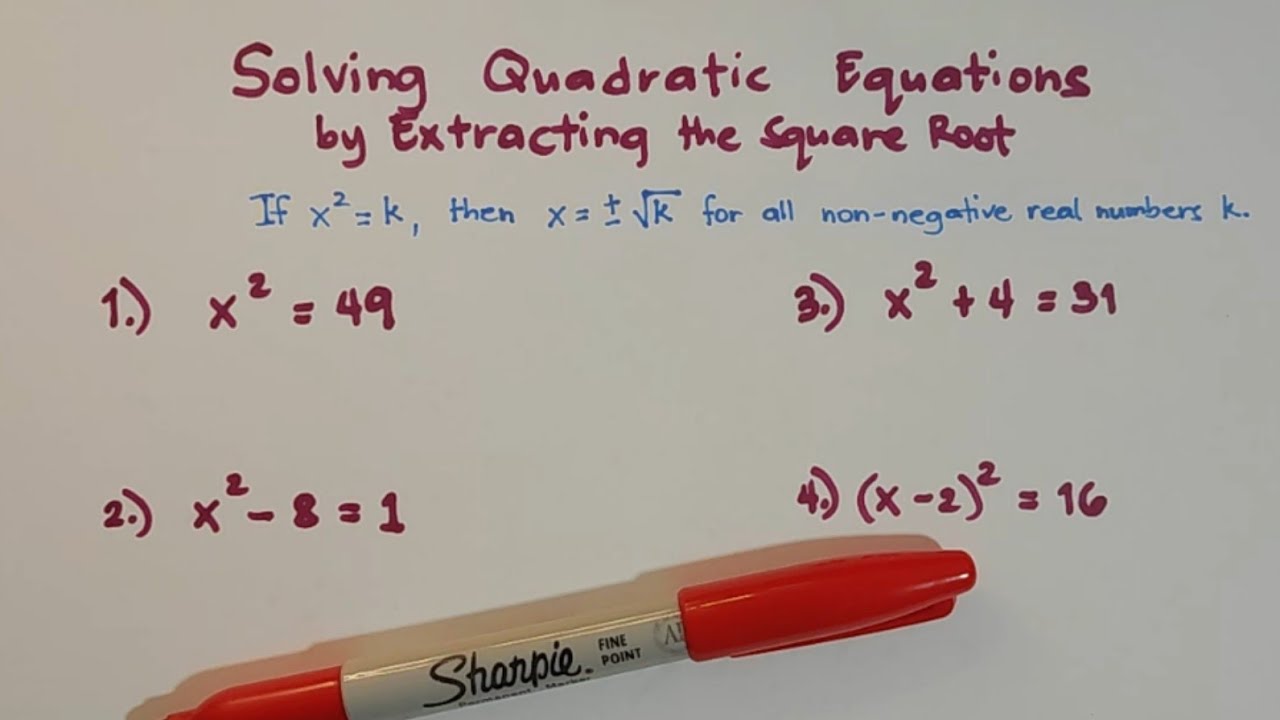SPM Mathematics Form 4 (Quadratic Functions & Equations in One Variable) Chapter 1 Complete Revision
Summary
TLDRTeacher Daisy's video script covers quadratic functions and equations in one variable. It explains the concept, general form, and characteristics of quadratic equations. The script discusses determining quadratic expressions, the graph's shape (a parabola), vertex as the max or min point, and finding these points. It explores the effects of 'a', 'b', and 'c' on the graph's shape and position. The script also teaches finding roots through factorization and graphical methods, and includes examples for clarity.
Takeaways
- 📐 The term 'quadratic' comes from 'quad' meaning square, as the variable is squared in quadratic expressions and equations.
- 🔢 A quadratic equation in one variable is an equation with the highest power of the variable being two, such as ax^2 + bx + c = 0, where a, b, and c are constants and a ≠ 0.
- 📉 The graph of a quadratic function is a parabola, which is U-shaped and can open upwards or downwards depending on the sign of a.
- 🔍 The vertex of a parabola is the maximum or minimum point and can be found using the formula x = -b/(2a).
- 📈 The value of a affects the width and direction of the parabola's opening: larger |a| results in a narrower parabola, and the sign of a determines if it opens upwards (positive) or downwards (negative).
- 📍 The value of b determines the position of the axis of symmetry relative to the y-axis.
- 📈 The value of c determines the y-intercept of the parabola, which is the point where the graph intersects the y-axis.
- 🔑 Quadratic functions can have real roots, imaginary roots, or touch the x-axis at one point, depending on the discriminant (b^2 - 4ac) of the equation.
- 🔍 To find the roots of a quadratic equation, methods such as factorization, the quadratic formula, completing the square, or graphing can be used.
- 📊 The graphical method to determine roots involves finding the points where the graph intersects the x-axis.
- 🎨 Sketching the graph of a quadratic function requires showing the correct shape, y-intercept, and x-intercepts or points that the graph passes through.
Q & A
What is the definition of a quadratic function?
-A quadratic function is a function of the form f(x) = ax^2 + bx + c, where a, b, and c are numbers with a not equal to zero.
What is the general form of a quadratic equation?
-The general form of a quadratic equation is ax^2 + bx + c = 0, where a, b, and c are constants and a cannot be zero.
What does the term 'quadratic' mean in the context of mathematics?
-The term 'quadratic' comes from 'quad' meaning square because the variable is squared in the equation.
How can you determine if an expression is a quadratic expression in one variable?
-An expression is a quadratic expression in one variable if it has only one variable, and the highest power of the variable is two.
What is the relationship between the value of 'a' and the direction in which the graph of a quadratic function opens?
-If a is greater than 0, the graph opens upward. If a is less than zero, the graph opens downward.
What is the vertex of a parabola?
-The vertex of a parabola is the bottom or top of the 'U' shape, also called the turning point or stationary point.
How do you find the x-value of the vertex of a quadratic function?
-To find the x-value of the vertex, you add up the two roots and divide by two.
What is the axis of symmetry of the graph of a quadratic function?
-The axis of symmetry is a vertical line drawn through the vertex of the parabola.
How does the value of 'b' affect the position of the axis of symmetry in a quadratic function?
-The value of 'b' determines the position of the axis of symmetry. If a is positive and b is positive, the axis of symmetry lies to the left of the y-axis, and so on.
What are the different methods to determine the roots of a quadratic equation?
-There are four methods to determine the roots of a quadratic equation: 1) factorization, 2) quadratic formula, 3) completing the square, and 4) graphing.
How can you sketch the graph of a quadratic function?
-To sketch the graph of a quadratic function, you should show the correct shape of the graph, the y-intercept, and the x-intercept or points that pass through the graph.
Outlines

This section is available to paid users only. Please upgrade to access this part.
Upgrade NowMindmap

This section is available to paid users only. Please upgrade to access this part.
Upgrade NowKeywords

This section is available to paid users only. Please upgrade to access this part.
Upgrade NowHighlights

This section is available to paid users only. Please upgrade to access this part.
Upgrade NowTranscripts

This section is available to paid users only. Please upgrade to access this part.
Upgrade NowBrowse More Related Video

Introduction to Quadratic Function | Examples of Quadratic Function

Fungsi Kuadrat [Part 6] - Bentuk Umum Fungsi Kuadrat

Linear and quadratic systems — Basic example | Math | SAT | Khan Academy

How to Solve Quadratic Equations by Extracting the Square Root? @MathTeacherGon

Maths - EB11 - S - chap2 - v1 - polynomes et equation du second degre

INTRODUCTION TO QUADRATIC EQUATIONS | GRADE 9
5.0 / 5 (0 votes)